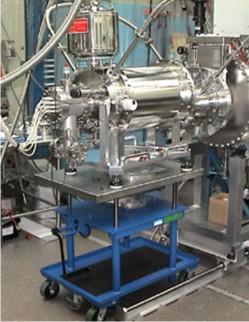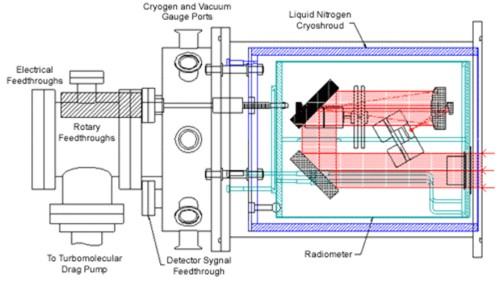BMDO transfer radiometer (BXR)

NIST developed the BMDO transfer radiometer (BXR) to calibrate small-aperture blackbodies for the test facilities of the Missile Defense Agency (MDA). In several cases, these blackbodies are used in the MDA chambers as the input of collimating optics that provide large beams of highly collimated and spectrally filtered infrared radiation for testing infrared arrays and systems. Because the throughput of the collimating optics is not often known to a satisfactory uncertainty, simply knowing the input radiance is sometimes not enough to establish adequate NIST traceability of the output irradiance. The BXR is a portable filter radiometer designed to measure low-level irradiance in highly collimated beams in a low-background environment.
A diagram of the optical layout of the BXR is shown below. The incoming collimated beam from the user source passes through a 7 cm defining aperture and is directed through a set of rotating filter wheels using mirror optics. A set of narrow-band filters is used for spectral selectivity, as well as linear polarizers for evaluating the polarization of the input beam. The beam is focused onto an arsenic-doped silicon blocked-impurity band (BIB) detector. The detector operates at temperatures near 12 K, while all other elements of the radiometer are cooled to temperatures below 20 K. The BXR bolts onto the host chamber and requires liquid helium and liquid nitrogen. It has a built in reference source as a stability monitor.

The BXR is tested and calibrated at the NIST LBIR facility against a 10 cm collimated source developed specially for this purpose. The collimated source is calibrated in a separate step against the ACR in the same facility. The BXR is capable of detecting irradiance levels as low as 10-15 W/cm2 over the spectral range from 2 µm to 30 µm. The standard uncertainty goal is 5% for irradiance levels up to 10-9 W/cm2.
The BXR has provided calibrated irradiance measurements of MDA test chamber output beams since 2001. Multiple visits to some user sites have established that their radiometric calibration is stable to within a few percent over a period of several years.
Specifications/Capabilities
- Transfer standard to NIST absolute cryogenic radiometer (ACR)
- Measure collimated beam with irradiance input levels between 10-15 W/cm2 and 10-9 W/cm2
- Spectrally resolve beams over IR wavelengths from 2 µm to 30 µm with 2% - 6% bandpass
- Evaluate linear polarization of collimated beam
- Easily transported with support equipment
- Self contained vacuum and cryogenic systems for operation external to test chamber being evaluated

